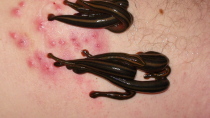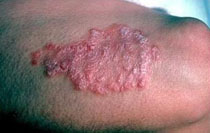Skin Diseases
The skin is the body's primary line of defense against infection. There are three common layers to the skin - Epidermis, Dermis and Hypodermis, composed of skin cells, capillaries, sweat glands, and hair follicles.
Common skin diseases often occur in the two uppermost layers, the epidermis and the dermis. Uncomplicated skin diseases are easily cured because the skin generally sheds after a couple of days, but more complicated skin diseases are rooted at the hypodermis level and these are more difficult to cure. Some skin diseases are rendered incurable and only subject to remission and exacerbation; that is, they remain idle on occasions and flare up from time to time.
The Ancient Science of Leech Therapy
Leeches shown during treatment of
varied conditions
Leech Therapy or Hirudotherapy has been practiced for centuries and is still widely used today. Although there is not much documentation available, leech therapy is still well accepted in many parts of the world.
Hirudotherapy is the use of medical leeches for the treatment of a variety of diseases. Each leech can absorb a small amount of blood, no more than 10 to 15 ml at a time and, as such, several leeches are used during each therapeutic session. According to many ancient beliefs, Hirudotherapy is included in the five bio-purificatory procedures that are based on the belief that the removal of unclean and impure blood treats the root of all sufferings.
Hirudotherapy for Alopecia
Alopecia is more commonly known as baldness. We are not talking about the normal age-related baldness, but the gradual and radical hair loss due to a fungal infection or dandruff.
Medicinal Leeches
About 100 hairs are naturally lost from the head every day, though the average human scalp contains between 100,000 and 150,000 hairs. Genetic baldness is caused by the body's failure to produce sufficient new hairs, not by excessive hair loss. It affects men more than women, although women also can develop a characteristic pattern of hair loss. About one quarter of men have started balding by the time they are thirty, and about two thirds are either bald or are balding by 60.
One of the advantages of Hirudotherapy is improvement of blood circulation. Bald spots in your head have less hair density because they have less blood circulation compared to other parts. The proliferation of fungi in the area can be one of the factors that cause the reduced blood flow.
Leech therapy is not generally associated with treating alopecia, but is very effective nonetheless. Blood circulation improves as a result and the body's natural defense against fungal infection can once again be delivered to the affected areas, thereby promoting healing.
Hirudotherapy to Treat Boils
Leeches shown during treatment of
varied conditions
Boils are infections deep in the skin. A boil begins as a red area and gradually becomes tender and firm. An 'eye' forms at the center and contains yellow fluid called pus, which is composed of white blood cells, dead bacteria and proteins.
During leech therapy, leeches are placed directly over the eye of the boil, so they can feed directly on the pus and at the same time, other leeches will be placed around the area to rid the body of pooled blood. This is important, because pooled blood causes pressure, leading to tenderness and will relieve the patient of pain.
Hirudotherapy to Treat Shingles
Shingles [Herpes Zoster] is a viral skin disease in adults and occurs due to reactivation in adulthood of dormant viral matter leftover from a bout of chickenpox in childhood. Although lifelong immunity to chickenpox is commonly spoken about, the viruses that cause it may lie dormant for years in sensory nerve cells, reactivating themselves and causing an attack of shingles at times when the immune system is weak, resulting in inflammation, pain, and a rash of small skin blisters.
Example of psoriasis
The skin manifestation of herpes zoster is not serious, but the pain caused by the inflammation of the underlying nerve can be severe, lasting for weeks.
Treatment for Shingles is designed merely to limit the severity and duration of pain because there are usually post infection complications like neuralgia [chronic severe pain around a nerve path]. Leeches saliva contains a substance that has analgesic [pain killing] effects. Pain relief is known to be more powerful and longer lasting than general pain relieving tablets.
Hirudotherapy for Psoriasis
There are many skin diseases that can be treated with Hirudotherapy and one disease worth mentioning is Psoriasis.
Psoriasis is a common skin condition that occurs when the skin cells replace themselves too quickly. There are many different types, but the most common is chronic plaque psoriasis.
What are the symptoms?
The extent of the disease can vary from a few tiny lesions here and there on the body, but are most commonly seen on knees, elbows, the chest and scalp, appearing as red, scaly patches that reveal fine silvery scales when scraped or scratched and often itch and feel uncomfortable. This condition can cause sufferers to become withdrawn and uncomfortable in forming relationships because of the way people react to the appearance of their skin.
What causes it?
Why psoriasis occurs is unknown, which makes it quite impossible to prevent. However, many things are thought to trigger the condition, including skin injury, sore throats/chest infections, some drug treatments, sunburn and even stress. As hopeless as it all may sound, ancient doctors have been using Hirudotherapy to improve the outcome of skin diseases like psoriasis. Not only are leeches useful for sucking pooled blood, their saliva also contains active substances that are bactericidal [fights off bacteria that proliferates over thick layers of excess skin cells]. Other substances in the leech’s saliva also cause gradual slowing of skin cell production, giving noticeable relief for patients.





